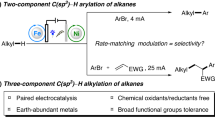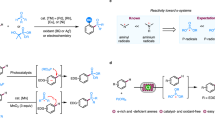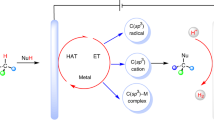Abstract
Preventing metal deposition by cathodic reduction is a formidable challenge during transition-metal-catalysed electrosynthesis under direct current (d.c.) electrolysis conditions, especially for noble metal catalysis. To overcome the limitation of reductive metal deposition, we now report an asymmetric-waveform alternating current (a.c.) electrolysis protocol for silver-catalysed C–H phosphorylation, where our a.c.-based approach achieves smooth regeneration of the silver catalyst. A wide variety of alkynes, alkenes and (hetero)arenes are reactive under our a.c. electrolysis conditions, delivering the desired phosphite ester derivatives (88 examples) in good yields, whereas these products are often obtained in poor yields under d.c. electrolysis conditions. Notably, this protocol can be expanded to Pd- and Cu-catalysed C–H functionalization. This electrochemical metal-catalysis strategy is distinct from traditional d.c. electrosynthesis and has great potential to be used in the fine organic chemical industry.

This is a preview of subscription content, access via your institution
Access options
Subscribe to this journal
Receive 12 digital issues and online access to articles
$119.00 per year
only $9.92 per issue
Buy this article
- Purchase on Springer Link
- Instant access to full article PDF
Prices may be subject to local taxes which are calculated during checkout




Similar content being viewed by others
Data availability
All data that support the findings of this study, which include device construction, experimental procedures and compound characterization, are available within the manuscript and its Supplementary Information. Source data are provided with this paper.
References
Kolbe, H. Untersuchungen über die elektrolyse organischer verbindungen. Justus Liebigs Ann. Chem. 69, 257–294 (1849).
Jutand, A. Contribution of electrochemistry to organometallic catalysis. Chem. Rev. 108, 2300–2347 (2008).
Moeller, K. D. Using physical organic chemistry to shape the course of electrochemical reactions. Chem. Rev. 118, 4817–4833 (2018).
Yan, M., Kawamata, Y. & Baran, P. S. Synthetic organic electrochemical methods since 2000: on the verge of a renaissance. Chem. Rev. 117, 13230–13319 (2017).
Wiebe, A. et al. Electrifying organic synthesis. Angew. Chem. Int. Ed. 57, 5594–5619 (2018).
Francke, R. & Little, R. D. Redox catalysis in organic electrosynthesis: basic principles and recent developments. Chem. Soc. Rev. 43, 2492–2521 (2014).
Kirubakaran, A., Jain, S. & Nema, R. K. A review on fuel cell technologies and power electronic interface. Renew. Sust. Energ. Rev. 13, 2430–2440 (2009).
Siwakoti, Y. P. et al. Impedance-source networks for electric power conversion part II: review of control and modulation techniques. IEEE Trans. Power Electr. 30, 1887–1906 (2015).
Rodrigo, S., Gunasekera, D., Mahajan, J. P. & Luo, L. Alternating current electrolysis for organic synthesis. Curr. Opin. Electrochem. 28, 100712 (2021).
Vehrenberg, J. et al. Steady-state electrochemical synthesis of HKUST-1 with polarity reversal. Micropor. Mesopor. Mater. 303, 110218 (2020).
Schotten, C. et al. Alternating polarity for enhanced electrochemical synthesis. React. Chem. Eng. 6, 147–151 (2021).
Lee, C. W., Cho, N. H., Nam, K. T., Hwang, Y. J. & Min, B. K. Cyclic two-step electrolysis for stable electrochemical conversion of carbon dioxide to formate. Nat. Commun. 10, 3919 (2019).
Blanco Daniela, E., Lee, B. & Modestino Miguel, A. Optimizing organic electrosynthesis through controlled voltage dosing and artificial intelligence. Proc. Natl Acad. Sci. 116, 17683–17689 (2019).
Lee, B., Naito, H., Nagao, M. & Hibino, T. Alternating-current electrolysis for the production of phenol from benzene. Angew. Chem. Int. Ed. 51, 6961–6965 (2012).
Hayashi, K., Griffin, J., Harper, K. C., Kawamata, Y. & Baran, P. S. Chemoselective (hetero)arene electroreduction enabled by rapid alternating polarity. J. Am. Chem. Soc. 144, 5762–5768 (2022).
Kawamata, Y. et al. Chemoselective electrosynthesis using rapid alternating polarity. J. Am. Chem. Soc. 143, 16580–16588 (2021).
Rodrigo, S. et al. Alternating current electrolysis for organic electrosynthesis: trifluoromethylation of (hetero)arenes. Org. Lett. 22, 6719–6723 (2020).
Fährmann, J. & Hilt, G. Alternating current electrolysis as efficient tool for the direct electrochemical oxidation of hydroxamic acids for acyl nitroso diels–alder reactions. Angew. Chem. Int. Ed. 60, 20313–20317 (2021).
Sattler, L. E., Otten, C. J. & Hilt, G. Alternating current electrolysis for the electrocatalytic synthesis of mixed disulfide via sulfur–sulfur bond metathesis towards dynamic disulfide libraries. Chem. Eur. J. 26, 3129–3136 (2020).
Bortnikov, E. O. & Semenov, S. N. Coupling of alternating current to transition-metal catalysis: examples of nickel-catalyzed cross-coupling. J. Org. Chem. 86, 782–793 (2021).
Yuan, Y. et al. Radical–radical cross-coupling assisted N–S bond formation using alternating current protocol. CCS Chem. 3, 3027–3038 (2021).
Wang, D. et al. Current electrolysis enabled formal C−O/O−H cross-metathesis of 4-alkoxy358 anilines with alcohols. Angew. Chem. Int. Ed. 61, e202201543 (2022).
Siu, J. C., Fu, N. & Lin, S. Catalyzing electrosynthesis: a homogeneous electrocatalytic approach to reaction discovery. Acc. Chem. Res. 53, 547–560 (2020).
Torabi, S., Jamshidi, M., Amooshahi, P., Mehrdadian, M. & Khazalpour, S. Transition metal-catalyzed electrochemical processes for C–C bond formation. New J. Chem. 44, 15321–15336 (2020).
Saint-Denis Tyler, G., Zhu, R.-Y., Chen, G., Wu, Q.-F. & Yu, J.-Q. Enantioselective C(sp3)‒H bond activation by chiral transition metal catalysts. Science 359, eaao4798 (2018).
Hickman, A. J. & Sanford, M. S. High-valent organometallic copper and palladium in catalysis. Nature 484, 177–185 (2012).
Cho, S. H., Kim, J. Y., Kwak, J. & Chang, S. Recent advances in the transition metal-catalyzed twofold oxidative C–H bond activation strategy for C–C and C–N bond formation. Chem. Soc. Rev. 40, 5068–5083 (2011).
Mkhalid, I. A. I., Barnard, J. H., Marder, T. B., Murphy, J. M. & Hartwig, J. F. C–H activation for the construction of C–B bonds. Chem. Rev. 110, 890–931 (2010).
Chen, J., Lv, S. & Tian, S. Electrochemical transition-metal-catalyzed C–H bond functionalization: electricity as clean surrogates of chemical oxidants. ChemSusChem 12, 115–132 (2019).
Ma, C., Fang, P. & Mei, T.-S. Recent advances in C–H functionalization using electrochemical transition metal catalysis. ACS Catal. 8, 7179–7189 (2018).
Wirtanen, T., Prenzel, T., Tessonnier, J.-P. & Waldvogel, S. R. Cathodic corrosion of metal electrodes—how to prevent it in electroorganic synthesis. Chem. Rev. 121, 10241–10270 (2021).
Amatore, C., Cammoun, C. & Jutand, A. Electrochemical recycling of benzoquinone in the Pd/benzoquinone-catalyzed heck-type reactions from arenes. Adv. Synth. Catal. 349, 292–296 (2007).
Ackermann, L. Metalla-electrocatalyzed C–H activation by earth-abundant 3d metals and beyond. Acc. Chem. Res. 53, 84–104 (2020).
Gandeepan, P., Finger, L. H., Meyer, T. H. & Ackermann, L. 3d metallaelectrocatalysis for resource economical syntheses. Chem. Soc. Rev. 49, 4254–4272 (2020).
Zeng, L. et al. Electrochemical oxidative aminocarbonylation of terminal alkynes. Nat. Catal. 3, 438–445 (2020).
Ma, C. et al. Transition metal-catalyzed organic reactions in undivided electrochemical cells. Chem. Sci. 12, 12866–12873 (2021).
Kakiuchi, F. et al. Palladium-catalyzed aromatic C–H halogenation with hydrogen halides by means of electrochemical oxidation. J. Am. Chem. Soc. 131, 11310–11311 (2009).
Zhong, J.-S., Yu, Y., Shi, Z. & Ye, K.-Y. An electrochemical perspective on the roles of ligands in the merger of transition-metal catalysis and electrochemistry. Org. Chem. Front. 8, 1315–1328 (2021).
Chow, H., Ingelsson, M., Roberts, E. P. L. & Pham, A. L.-T. How does periodic polarity reversal affect the faradaic efficiency and electrode fouling during iron electrocoagulation? Water Res. 203, 117497 (2021).
Torii, S., Inokuchi, T. & Sugiura, T. Indirect electrooxidation of alcohols and aldehydes by using a double mediatory system consisting of ruthenium tetraoxide/ruthenium dioxide and chlorine cation/chlorine anion redoxes in an aqueous-organic two-phase system. J. Org. Chem. 51, 155–161 (1986).
Liu, J., Xiao, H.-Z., Fu, Q. & Yu, D.-G. Advances in radical phosphorylation from 2016 to 2021. Chem. Synth. 1, 9 (2021).
Sbei, N., Martins, G. M., Shirinfar, B. & Ahmed, N. Electrochemical phosphorylation of organic molecules. Chem. Rec. 20, 1530–1552 (2020).
Wu, Z.-J. et al. Scalable rhodium(III)-catalyzed aryl C–H phosphorylation enabled by anodic oxidation induced reductive elimination. Angew. Chem. Int. Ed. 58, 16770–16774 (2019).
Wang, S., Xue, Q., Guan, Z., Ye, Y. & Lei, A. Mn-catalyzed electrooxidative undirected C–H/P–H cross-coupling between aromatics and diphenyl phosphine oxides. ACS Catal. 11, 4295–4300 (2021).
Zhang, J.-Q., Chen, T., Zhang, J.-S. & Han, L.-B. Silver-free direct synthesis of alkynylphosphine oxides via spC–H/P(O)–H dehydrogenative coupling catalyzed by palladium. Org. Lett. 19, 4692–4695 (2017).
Wang, T. et al. Silver-mediated selective oxidative cross-coupling between C–H/P–H: a strategy to construct alkynyl(diaryl)phosphine oxide. Org. Lett. 17, 118–121 (2015).
Gui, Q., Hu, L., Chen, X., Liu, J. & Tan, Z. Stereoselective synthesis of vinylphosphonates and phosphine oxides via silver-catalyzed phosphorylation of styrenes. Chem. Commun. 51, 13922–13924 (2015).
Gao, Y. et al. Copper-catalyzed aerobic oxidative coupling of terminal alkynes with H-phosphonates leading to alkynylphosphonates. J. Am. Chem. Soc. 131, 7956–7957 (2009).
Kagayama, T., Nakano, A., Sakaguchi, S. & Ishii, Y. Phosphonation of arenes with dialkyl phosphites catalyzed by Mn(II)/Co(II)/O2 redox Couple. Org. Lett. 8, 407–409 (2006).
Liu, J., Xiao, H.-Z., Fu, Q. & Yu, D.-G. Advances in radical phosphorylation from 2016 to 2021. Chem. Synth. 1, 9 (2021).
Acknowledgements
This work was supported by the National Key R&D Program of China (grant no. 2021YFA1500104, to A.L.), National Natural Science Foundation of China (grant no. 22031008, to A.L.), the Science Foundation of Wuhan (grant no. 2020010601012192, to A.L.) and the China Postdoctoral Science Foundation (grant nos. 2021M702520 and BX2021225, to L.Z.). We thank S. Tang from Shanghai Jiao Tong University and A. D. Chowdhury from Wuhan University for advising on the manuscript.
Author information
Authors and Affiliations
Contributions
A.L. and L.Z. contributed to the conception and design of the experiments. Y.J., W.Y., Y.W., S.W., P.W., D.W., Q.Y., J.W. and H.Z. performed the experiments. L.Z. and A.L. cowrote the manuscript and all authors contributed to data analysis and scientific discussion. L.Z., Y.J. and W.Y. contributed equally to this work.
Corresponding author
Ethics declarations
Competing interests
The authors declare no competing interests.
Peer review
Peer review information
Nature Synthesis thanks Long Luo and the other, anonymous, reviewer(s) for their contribution to the peer review of this work. Primary Handling Editor: Peter Seavill, in collaboration with the Nature Synthesis team.
Additional information
Publisher’s note Springer Nature remains neutral with regard to jurisdictional claims in published maps and institutional affiliations.
Supplementary information
Supplementary Information
Experimental details, Supplementary Sections 1–13, Figs. 1–41 and Tables 1–8.
Source data
Source data Fig. 2
Unprocessed atomic absorption spectrum data (Fig. 2c,d,e,f,i) and current data (Fig. 2h).
Rights and permissions
Springer Nature or its licensor (e.g. a society or other partner) holds exclusive rights to this article under a publishing agreement with the author(s) or other rightsholder(s); author self-archiving of the accepted manuscript version of this article is solely governed by the terms of such publishing agreement and applicable law.
About this article
Cite this article
Zeng, L., Jiao, Y., Yan, W. et al. Asymmetric-waveform alternating current-promoted silver catalysis for C–H phosphorylation. Nat. Synth 2, 172–181 (2023). https://doi.org/10.1038/s44160-022-00197-z
Received:
Accepted:
Published:
Issue Date:
DOI: https://doi.org/10.1038/s44160-022-00197-z
This article is cited by
-
Electroreduction of unactivated alkenes using water as hydrogen source
Nature Communications (2024)



